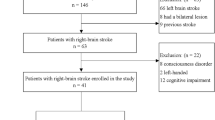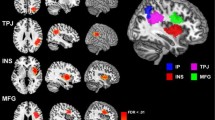Abstract
Attention can be directed to spatial locations or to objects in space. Patients with left unilateral spatial neglect are slow to respond to a left-sided target when it is preceded by a right-sided “invalid” cue, particularly at short cue-target intervals, suggesting an impairment in disengaging attention from the right side in order to orient it leftward. We wondered whether this deficit is purely spatial, or it is influenced by the presence of a right-sided visual object. To answer this question, we tested 10 right brain-damaged patients with chronic left-neglect and 41 control participants on a cued response time (RT) detection task in which targets could appear in either of two lateral boxes. In different conditions, non-informative peripheral cues either consisted in the brightening of the contour of one lateral box (onset cue condition), or in the complete disappearance of one lateral box (offset cue condition). The target followed the cue at different stimulus-onset asynchronies (SOAs). If the disengagement deficit (DD) is purely space-based, then it should not vary across the two cueing conditions. With onset cues, patients showed a typical DD at short SOAs. With offset cues, however, the DD disappeared. Thus, patients did not show any DD when there was no object from which attention must be disengaged. These findings indicate that the attentional bias in left-neglect does not concern spatial locations per se, but visual objects in space.



Similar content being viewed by others
References
Bartolomeo P (2007) Visual neglect. Curr Opin Neurol 20:381–386
Bartolomeo P, Chokron S (1999) Egocentric frame of reference: its role in spatial bias after right hemisphere lesions. Neuropsychologia 37:881–894
Bartolomeo P, Chokron S (2002) Orienting of attention in left unilateral neglect. Neurosci Biobehav Rev 26:217–234
Bartolomeo P, Chokron S, Siéroff E (1999) Facilitation instead of inhibition for repeated right-sided events in left neglect. Neuroreport 10:3353–3357
Bartolomeo P, Lupiáñez J (2006) Inhibitory after-effects in spatial processing: experimental and theoretical issues on inhibition of return. Cogn Neuropsychol 23
Bartolomeo P, Siéroff E, Decaix C, Chokron S (2001) Modulating the attentional bias in unilateral neglect: the effects of the strategic set. Exp Brain Res 137:424–431
Bartolomeo P, Urbanski M, Chokron S, Chainay H, Moroni C, Siéroff E, Belin C, Halligan P (2004) Neglected attention in apparent spatial compression. Neuropsychologia 42:49–61
Behrmann M, Tipper SP (1999) Attention accesses multiple reference frames: evidence from visual neglect. J Exp Psychol Hum Percept Perform 25:83–101
Chokron S, Colliot P, Bartolomeo P (2004) The role of vision on spatial representations. Cortex 40:281–290
D’Erme P, Robertson IH, Bartolomeo P, Daniele A, Gainotti G (1992) Early rightwards orienting of attention on simple reaction time performance in patients with left-sided neglect. Neuropsychologia 30:989–1000
Egly R, Driver J, Rafal RD (1994) Shifting visual attention between objects and locations: evidence from normal and parietal lesion patients. J Exp Psych Gen 123:161–177
Faust ME, Balota DA (1997) Inhibition of return and visuospatial attention in healthy older adults and individuals with dementia of the Alzheimer type. Neuropsychology 11:13–29
Friedrich FJ, Egly R, Rafal RD, Beck D (1998) Spatial attention deficits in humans: a comparison of superior parietal and temporal-parietal junction lesions. Neuropsychology 12:193–207
Gainotti G, D’Erme P, Bartolomeo P (1991) Early orientation of attention toward the half space ipsilateral to the lesion in patients with unilateral brain damage. J Neurol Neurosurg Psychiatr 54:1082–1089
Làdavas E, Umiltà C, Ziani P, Brogi A, Minarini M (1993) The role of right-sided objects in left side neglect: a dissociation between perceptual and directional motor neglect. Neuropsychologia 31:761–773
Loetscher T, Brugger P (2007) A disengagement deficit in representational space. Neuropsychologia 45:1299–1304
Losier BJ, Klein RM (2001) A review of the evidence for a disengage deficit following parietal lobe damage. Neurosci Biobehav Rev 25:1–13
Lupiáñez J, Decaix C, Siéroff E, Chokron S, Milliken B, Bartolomeo P (2004) Independent effects of endogenous and exogenous spatial cueing: Inhibition of return at endogenously attended target locations. Exp Brain Res 159:447–457
Lupiáñez J, Ruz M, Funes MJ, Milliken B (2007) The manifestation of attentional capture: facilitation or IOR depending on task demands. Psychol Res 71:77–91
Mark VW, Kooistra CA, Heilman KM (1988) Hemispatial neglect affected by non-neglected stimuli. Neurology 38:640–643
Morrow LA, Ratcliff G (1988) The disengagement of covert attention and the neglect syndrome. Psychobiology 16:261–269
Müller HJ, Rabbitt PM (1989) Reflexive and voluntary orienting of visual attention: time course of activation and resistance to interruption. J Exp Psychol Hum Percept Perform 15:315–330
Posner MI (1980) Orienting of attention. Q J Exp Psychol 32:3–25
Posner MI, Cohen Y (1984) Components of visual orienting. In: Bouma H, Bouwhuis D (eds) Attention and performance X. Lawrence Erlbaum, London, pp 531–556
Posner MI, Rafal RD, Choate LS, Vaughan J (1985) Inhibition of return: neural basis and function. Cogn Neuropsychol 2:211–228
Posner MI, Walker JA, Friedrich FA, Rafal RD (1987) How do the parietal lobes direct covert attention? Neuropsychologia 25:135–145
Posner MI, Walker JA, Friedrich FJ, Rafal RD (1984) Effects of parietal injury on covert orienting of attention. J Neurosci 4:1863–1874
Pratt J, McAuliffe J (2001) The effects of onsets and offsets on visual attention. Psychol Res 65:185–191
Riggio L, Bello A, Umiltà C (1998) Inhibitory and facilitatory effects of cue onset and offset. Psychol Res 61:107–118
Siéroff E, Decaix C, Chokron S, Bartolomeo P (2007) Impaired orienting of attention in left unilateral neglect: a componential analysis. Neuropsychology 21:94–113
Smania N, Martini MC, Gambina G, Tomelleri G, Palamara A, Natale E, Marzi CA (1998) The spatial distribution of visual attention in hemineglect and extinction patients. Brain 121:1759–1770
Striemer C, Danckert J (2007) Prism adaptation reduces the disengage deficit in right brain damage patients. Neuroreport 18:99–103
Urbanski M, Bartolomeo P (2008) Line bisection in left neglect: the importance of starting right. Cortex
Valdes-Sosa M, Bobes MA, Rodriguez V, Pinilla T (1998) Switching attention without shifting the spotlight object-based attentional modulation of brain potentials. J Cogn Neurosci 10:137–151
Vivas AB, Humphreys GW, Fuentes LJ (2006) Abnormal inhibition of return: a review and new data on patients with parietal lobe damage. Cogn Neuropsychol 23:1049–1064
Yantis S, Jonides J (1990) Abrupt visual onsets and selective attention: voluntary versus automatic allocation. J Exp Psychol Hum Percept Perform 16:121–134
Author information
Authors and Affiliations
Corresponding authors
Rights and permissions
About this article
Cite this article
Rastelli, F., Funes, MJ., Lupiáñez, J. et al. Left visual neglect: is the disengage deficit space- or object-based?. Exp Brain Res 187, 439–446 (2008). https://doi.org/10.1007/s00221-008-1316-x
Received:
Accepted:
Published:
Issue Date:
DOI: https://doi.org/10.1007/s00221-008-1316-x




